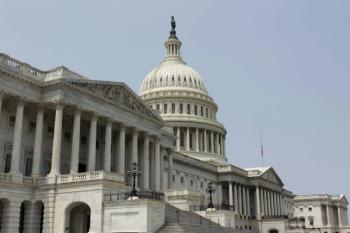
- June 2020
- Volume 5
- Issue 3
COVID-19 Complicates an Already Difficult Presentation of Infective Endocarditis
Final Diagnosis: Infective Endocarditis Due to Granulicatella adiacens and Streptococcus mitis.
Granulicatella adiacens is a type of nutritionally variant streptococci (NVS) first described in 1961.1 NVS are gram-positive cocci that form satellite colonies and require a medium with pyridoxine and cysteine for growth. They are classified into 2 genera, Abiotrophia and Granulicatella, comprising 4 species: Abiotrophia defectiva, G adiacens, Granulicatella elegans, and Granulicatella balaenopterae.2 These bacteria are part of the normal oropharyngeal, gastrointestinal, and urogenital flora.3 NVS are an important cause of bacteremia and infective endocarditis (IE).2-4 NVS are responsible for about 5% of cases IE caused by streptococci.4 Few case reports are described in the literature.5-10 This article describes a case of IE due to G adiacens and Streptococcus mitis.
THE CASE
A 49-year-old woman presented to the hospital from her hemo­dialysis appointment with a fever and a cough. Three days prior, she had begun feeling symptoms of myalgias, fatigue, and worsening cough, causing her to miss her initial hemodialysis appointment. Upon presentation to the following hemodialysis appointment, the patient was febrile to 101 °F and complained of a productive cough, prompting admission.
The patient had a medical history of end-stage renal disease on hemodialysis, type 2 diabetes mellitus, posterior uveitis, peripheral artery disease status post below-knee amputation, pulmonary embolism 10 years prior, cerebrovascular accident, and epilepsy. She has been receiving hemodialysis for 6 years via an arteriovenous graft. The patient had documented allergies to penicillin and amoxicillin, with multiple skin abscesses noted as a reaction with amoxicillin use. She also had a listed ciprofloxacin allergy with an unknown reaction.
At presentation, the patient was taking aspirin, calcium acetate, lanthanum, cyanocobalamin, folic acid, insulin glargine, lamotrigine, levetiracetam, omeprazole, and tamsu­losin. Additionally, the patient took difluprednate and neomycin-polymyxin-hydrocortisone eye drops.
CLINICAL COURSE
On the patient’s initial presentation, the physical exam was unremarkable and vital signs were within normal limits. However, the patient was intermittently febrile throughout the first 3 days of her admission, with a maximum tempera­ture of 103.2 °F on day 2. Initial laboratory data revealed an elevated C-reactive protein level of 3.4 mg/dL, a decreased absolute lymphocyte count of 0.9 × 109 cells/L, an elevated IL-6 level of 47.83 pg/mL, an elevated D-dimer level of 0.774 ug/mL, and an elevated ferritin level of 848 ng/mL. Initial blood cultures were obtained and ultimately resulted in no growth. A CT scan of the thorax revealed scattered nodular and patchy ground-glass opacities within the right upper and left upper lobes. Given the current pandemic and the patient’s clinical presentation, the patient was tested for severe acute respiratory syndrome coronavirus 2 (SARS-CoV-2), and the nasopharyngeal polymerase chain reaction assay was positive.
On day 3, the patient received a diagnosis of cytokine storm, most likely the result of her current SARS-CoV-2 infection. Her C-reactive protein level increased to 15.5 mg/dL and her ferritin level to 1945 ng/mL. The patient was given tocilizumab on day 3 and intravenous immunoglobulin on days 5 to 7. Her IL-6 level on day 5 was 4829.01 pg/mL. On day 6, the patient required intubation because of increasing oxygen requirements.
Two sets of blood cultures were obtained on day 8 because of no improvement in inflamma­tory markers and a low threshold for suspicion of infection, as the patient had received immu­nomodulatory therapy. She was started empir­ically on cefepime and vancomycin. One set of blood cultures grew G adiacens, and the second set grew S mitis. The patient was switched to ceftaroline and gentamicin, and a transthoracic echocardiogram (TTE) was obtained. Ceftaroline was selected because of the variable data of G adiacens susceptibility to other β-lactams, such as penicillin and ceftriaxone. Additionally, there were challenges with appropriately admin­istering vancomycin. The TTE revealed a small, mobile mass on the mitral valve, confirming a diagnosis of infective endocarditis.
The G adiacens was susceptible to penicillin, meropenem, vancomycin, and levofloxacin, and the S mitis was susceptible to penicillin G, ceftriaxone, cefepime, and vancomycin. Upon receipt of susceptibilities, the patient was switched from ceftaroline back to vanco­mycin for ease of dosing with hemodialysis. Concerns also existed regarding alternative antimicrobial therapy options because of docu­mented allergies. Gentamicin was continued. Subsequent blood cultures were negative. The
patient’s central venous catheter and arterial lines, which had been placed on day 6, were removed on day 19.
As of this writing, the patient is clinically improving. She has continued to be afebrile, and her white blood cell count is within normal limits at 6.1 × 109 cells/L. Her oxygen requirements have significantly decreased, as she was extubated on day 15 and is on 3 L of oxygen via nasal cannula, saturating at 100%. The patient is anticipated to receive a total of 4 weeks of antimicrobial therapy with vancomycin and gentamicin with hemodialysis sessions. The gentamicin is to be discontinued upon discharge.
DISCUSSION
Endocarditis due to NVS typically follows a slow and indolent course, which is concerning for significant destruction of the heart valves.6 This destruction is thought to be due to the cha gene present in A defectiva and G adiacens, which produces a protein that binds to fibronectin of the host cell.11 This relationship with fibronectin-binding capacity is an important step in the pathogenesis of IE.
Current guidelines recommend that IE caused by Granulicatella species should be treated with penicillin or ampicillin in combination with gentamicin for 4 to 6 weeks, similar to treatment for IE due to enterococci.12,13 In patients with penicillin or ceftriaxone allergies, vancomycin is recommended without gentamicin. Previous literature suggests variable susceptibility of NVS, with 30% to 70% of G adiacens isolates susceptible to penicillin, 40% to 80% susceptible to ceftri­axone, and 100% susceptible to vancomycin.2,14,15 Half of the G adiacens isolates that were resistant to ceftriaxone were susceptible to ceftaroline, and the minimum inhibitory concentration (MIC90) was lower for ceftaroline than for ceftriaxone and cefotaxime.2 Despite effective antimicrobial therapy, NVS is associated with a 17% mortality rate, a 17% relapse rate, a 30% embolization rate, and a 41% bacteriologic failure rate.5,16
This case is unique given the patient’s initial presentation, administration of immunomodu­latory therapy, and documented allergies. It is also an example of how other infections may occur concomitantly in patients with corona­virus disease 2019 and serves as a reminder to remain suspicious for them. IE due to NVS is hard to treat. Identifying these pathogens can be difficult because of their fastidious nature, which may delay treatment and lead to further complications such as valvular destruction.
Campanella is a PGY2 resident in infectious diseases pharmacy at Temple University School of Pharmacy in Philadelphia, Pennsylvania. She completed her PharmD at Thomas Jefferson University College of Pharmacy and a PGY1 residency at Penn State Health Milton S. Hershey Medical Center in Pennsylvania. *She is an active member of the Society of Infectious Diseases Pharmacists and Making a Difference in Infectious Diseases (MAD-ID).
References:
1. Frenkel A, Hirsch W. Spontaneous Development of L Forms of Streptococci requiring Secretions of Other Bacteria or Sulphydryl Compounds for Normal Growth. Nature. 1961;191(4789):728-730. doi:10.1038/191728a0
2. Alberti MO, Hindler JA, Humphries RM. Antimicrobial Susceptibilities of Abiotrophia defectiva, Granulicatella adiacens, and Granulicatella elegans. Antimicrob Agents Chemother. 2016;60(3):1411-1420. doi:10.1128/AAC.02645-15
3. Ruoff KL. Nutritionally Variant Streptococci. CLIN MICROBIOL REV. 1991;4:7.
4. Roberts RB, Krieger AG, Schiller NL, Gross KC. Viridans streptococcal endocarditis: the role of various species, including pyridoxal-dependent streptococci. Rev Infect Dis. 1979;1(6):955-966. doi:10.1093/clinids/1.6.955
5. Adam EL, Siciliano RF, Gualandro DM, et al. Case series of infective endocarditis caused by Granulicatella species. International Journal of Infectious Diseases. 2015;31:56-58. doi:10.1016/j.ijid.2014.10.023
6. Verdecia J, Vahdat K, Isache C. Trivalvular infective endocarditis secondary to Granulicatella adiacens and Peptostreptococcus spp. IDCases. 2019;17. doi:10.1016/j.idcr.2019.e00545
7. Patil SM, Arora N, Nilsson P, Yasar SJ, Dandachi D, Salzer WL. Native Valve Infective Endocarditis with Osteomyelitis and Brain Abscess Caused by Granulicatella adiacens with Literature Review. Case Rep Infect Dis. 2019;2019. doi:10.1155/2019/4962392
8. Shailaja TS, Sathiavathy KA, Unni G Infective endocarditis caused by Granulicatella adiacens. Indian Heart Journal. 2013;65(4):447-449. doi:10.1016/j.ihj.2013.06.014
9. Garibyan V, Shaw D. Bivalvular endocarditis due to Granulicatella adiacens. Am J Case Rep. 2013;14:435-438. doi:10.12659/AJCR.889206
10. Macin S, Inkaya A, Tuncer Ö, Ünal S, Akyön Y. Infections related to Granulicatella adiacens: Report of two cases and review of literature. Indian Journal of Medical Microbiology; Chandigarh. 2016;34(4). doi:http://dx.doi.orG libproxy.temple.edu/10.4103/0255-0857.195377
11. Yamaguchi T, Soutome S, Oho T. Identification and characterization of a fibronectin-binding protein from Granulicatella adiacens. Molecular Oral Microbiology. 2011;26(6):353-364. doi:10.1111/j.2041-1014.2011.00623.x
12. Habib G, Lancellotti P, Antunes MJ, et al. 2015 ESC Guidelines for the management of infective endocarditis: The Task Force for the Management of Infective Endocarditis of the European Society of Cardiology (ESC)Endorsed by: European Association for Cardio-Thoracic Surgery (EACTS), the European Association of Nuclear Medicine (EANM). Eur Heart J. 2015;36(44):3075-3128. doi:10.1093/eurheartj/ehv319
13. Baddour LM, Wilson WR, Bayer AS, et al. Infective Endocarditis in Adults: Diagnosis, Antimicrobial Therapy, and Management of Complications. Circulation. 2015;132(15):1435-1486. doi:10.1161/CIR.0000000000000296
14. Murray CK, Walter EA, Crawford S, Leticia McElmeel M, Jorgensen JH. Abiotrophia Bacteremia in a Patient with Neutropenic Fever and Antimicrobial Susceptibility Testing of Abiotrophia Isolates. Clinical Infectious Diseases. 2001;32(10):e140-e142. doi:10.1086/320150
15. Tuohy MJ, Procop GW, Washington JA. Antimicrobial susceptibility of Abiotrophia adiacens and Abiotrophia defectiva. Diagnostic Microbiology and Infectious Disease. 2000;38(3):189-191. doi:10.1016/S0732-8893(00)00194-2
16. Stein DS, Nelson KE. Endocarditis due to nutritionally deficient streptococci: therapeutic dilemma. Rev Infect Dis. 1987;9(5):908-916. doi:10.1093/clinids/9.5.908
Articles in this issue
over 5 years ago
COVID-19: A Primerover 5 years ago
How Close Are We to a Cure for HIV?over 5 years ago
Lefamulin: An Overview of a Lonely Soldierover 5 years ago
Improving Vaccine Uptake in a Cohort of Patients With Aspleniaover 5 years ago
The Future of Health Care After COVID-19over 5 years ago
COVID-19 Preprints: Reader, BewareNewsletter
Stay ahead of emerging infectious disease threats with expert insights and breaking research. Subscribe now to get updates delivered straight to your inbox.





























































































































































































































































































